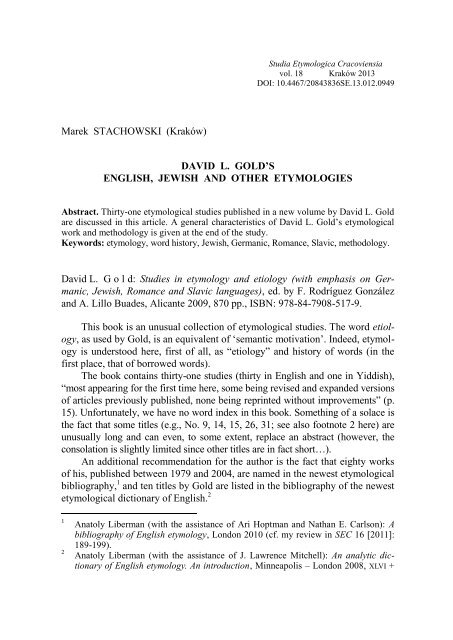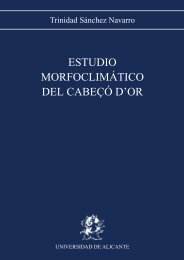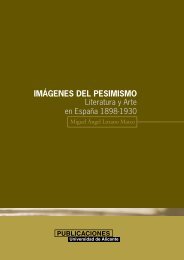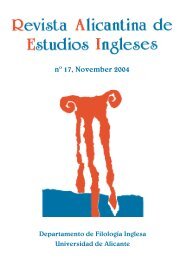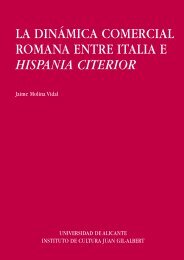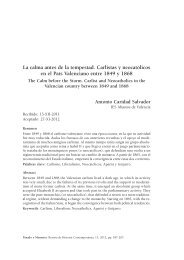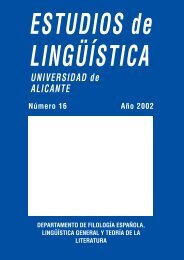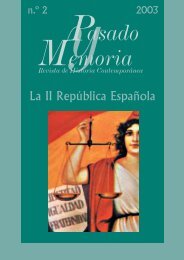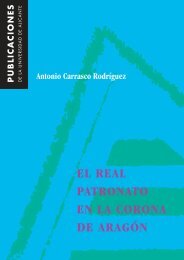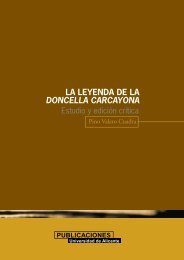DAVID L. GOLD'S ENGLISH, JEWISH AND OTHER ETYMOLOGIES ...
DAVID L. GOLD'S ENGLISH, JEWISH AND OTHER ETYMOLOGIES ...
DAVID L. GOLD'S ENGLISH, JEWISH AND OTHER ETYMOLOGIES ...
You also want an ePaper? Increase the reach of your titles
YUMPU automatically turns print PDFs into web optimized ePapers that Google loves.
<strong>DAVID</strong> L. GOLD’S <strong>ETYMOLOGIES</strong> 171However, the Chicano Spanish word blanquillo emulated the middle phasein (e) and, thus, blanquillo, too, received a new meaning: ‘testicle’. As Goldputs it (p. 51): “With that change, the purpose for which blanquillo was coined– to avoid having one word meaning both ‘egg’ and ‘testicle’ – was defeated”.The presentation in (f) should be in that event changed into:(f') blanquillo E (→ T).Approximately the same can be observed in Polish, too. The diminutiveform jajko was introduced to avoid the ambiguity of jajo, see (a') above. However,the stylistic tendency triggered the change in (b"), the result (albeit notnecessarily all details) being the same as in Chicano Spanish, cf. (b") with (f).3. The British English origin of informal Israeli Hebrew braso (p. 53-55).Gold’s aim here is to show that the Israeli Hebrew slangism braso ‘1. militarypolice; 2. military police officer’ derives from a British English word braso‘1. 2. id.’ that, in its own turn, reflects the English proprietary name of a certainbrand of polish: 3 Brasso (used, e.g., for brass buttons at uniforms) which, incidentally,is used in Israeli Hebrew, too. In the meantime, the meaning of ‘militarypolice (officer)’ became obsolete in Hebrew, unlike the proprietary namethat is still in use both in English and Hebrew.This article is a nice etymological study and, at the same time, a good exampleof an obsolete meaning that usually cannot be found in a retrospectiveetymological dictionary (and most etymological dictionaries are retrospective) –a clear argument against those who doubt about the sense of publishing prospectiveetymological dictionaries.4. American English slang copacetic ‘fine, all right’ has no Hebrew, Yiddishor other Jewish connection (p. 57-76).Various etymologies have been suggested for the American English slangismcopacetic. None has been generally accepted. Gold cannot solve the mysteryeither, but he can at least show that neither Hebrew nor Yiddish could havebeen the source. In fact, this is quite a normal situation in etymological researchbut this article contains also a somewhat more general conclusion: “The onlyvalue of the yarn about the Hebrew or Yiddish origin of copacetic is thereforeshibbolethic: if you hear it, you can be sure that the storyteller is a linguistic3Not “a certain brand of Polish”, as a printing gremlin spelled on p. 54.
172 MAREK STACHOWSKIdilettante” (p. 74). Indeed, the conclusion brings solace to every etymologistwho has, from time to time, to discuss in public (aunt Ann’s birthday, etc.) theorigin of various words, risking yet another encounter with resolute advocatesof folk-etymologies. One cannot but regret that this sentence of Gold’s is notplaced as words of wisdom at the very end of the article.5. The American English slangism fink probably has no Jewish connection(p. 77-85).It is important to know that this article “is a revised and expanded version”of a 1998 article, “which is in turn a revision and expansion of remarks” (p. 77,fn. 1) that were first published in 1983. Thus, it may be viewed as an emotionalreaction against a 1980 article by Renate L. & Steven M. Benjamin on the“Origin of American English fink” (p. 80). Apart from a discussion of details,Gold formulates also a somewhat more general idea here: “If my reaction to theBenjamins’ musings about Yiddish are angry, the tone is justified: Yiddishhaving long been the terra incognita of Germanic studies (it still is), certain studentsof German outrageously suppose that whatever is German must be Yiddishtoo or that a knowledge of German qualifies them to be students of Yiddishalso” (p. 81sq.). This is a great problem, indeed. American etymologists feelexcited when citing a Yiddish word, while Slavonic etymologists feel proud andhappy, when citing a Hungarian or Turkish word – exotic words are attractiveenough to be adduced again and again, even if the authors are not ready to learnany exotic language. 4What concerns Gold’s counter-arguments against the possibility of derivingthe American slang word fink from the Ashkenazic Jewish family nameFink, occurring in a joke (p. 78) as the name of an “untrustworthy tailor”, oneremark should be made: Even if the general line of reasoning (and also, by thesame token, the final negative conclusion) is probably correct, argument 3 (p.79) appears to me somewhat less certain. It goes as follows: “[…] the presenceof the rise-fall intonation in the joke leads us to conclude that it was made up inEastern Ashkenazic English-speaking circles and has been told only in thosecircles”. Now, it is virtually a rule in Polish to retell original Jewish jokes withwhat is called “Jewish intonation” in Poland (of course, as far as a Pole can imitateit; however, generally even those who cannot nevertheless do try). That iswhy I am slightly skeptical about the claim that only Eastern Ashkenazic circlescould retell the joke with the rise-fall intonation in America.4Cf. also my remarks on Siberian data used for the etymology of mammoth (in: FoliaOrientalia 36 [2000]: 304sq.) and those on the general state of Slavonic philologists’Turkological ignorance (in: Studia Turcologica Cracoviensia 10 [2005]: 438, fn. 6).
178 MAREK STACHOWSKIstronger than no’ […], it may well come from an emphatic expression. Aber nit!is indeed emphatic” (p. 246).12. English paparazzo < Italian paparazzo = communization of the labelname paparazzo (in Federico Fellini’s La dolce vita) < ? (p. 257-266).Apart from sporadic and rather weird “misetymologies” (as Gold callsthem) as Engl. paparazzo < Italian < French paperassier ‘scribbler, rummage inold papers’ < paperasse ‘old/waste paper’ < papier ‘paper’ (see p. 264), theword paparazzo is generally derived from the name Paparazzo, as borne by aphotographer in Federico Fellini’s film La dolce vita. Gold, too, accepts this explanation.His aim is, thus, not to find an unknown etymology but to elucidateone detail: was there between the Italian personal name and the English commonname an intermediary stage in form of an Italian common name?Gold shows that the Italian plural form paparazzi was many times used assingular in English-language newspapers which points to the existence of anItalian common noun paparazzo, pl. paparazzi. Gold is certainly right when saying“[…] if English paparazzo were based directly on the film character’s name,English paparazzo would be frequent [which actually is not the case – M. S.]and the plural of the English word would probably be paparazzos, that is, regularlyformed” (p. 163).13. New York City English parky ‘park-keeper’ is probably a spontaneouscoinage rather than a borrowing from British English (p. 267-269).The word parky, known primarily in northern England and Scotland aswell as in America, “could have been coined in New York City independentlyof the British English word. Or, the American word could be of British origin”(p. 268sq.).In case of a word that is morphologically perfectly transparent and bothpossibilities are approximately equally imaginable, a reasonable decision mightseem rather unachievable. Gold cannot offer an ultimate solution, to be sure, buthis way of reasoning shed at least some light on the problem: Since “the Britishword is recorded considerably earlier than the New York City one” and lexicalborrowings are made rather through mass media than through direct contactwith Scottish immigrants in recent years (p. 269) the word parky “is likeliest tobe an independent local coinage” (l.c.).
<strong>DAVID</strong> L. GOLD’S <strong>ETYMOLOGIES</strong> 17914. When chauvinism interferes in etymological research: A few observationson the supposed Vulgar Latin derivation of Rumanian pastramă~ păstramă, a noun of immediate Turkish origin (with preliminaryremarks on related words in Albanian, Arabic, Armenian, English,French, Greek, Hebrew, Judezmo, Polish, Russian, Serbocroatian,Spanish, Turkish, Ukrainian, and Yiddish) (p. 271-375).Even if this author calls his article “only a preliminary statement” (p. 313),it is over one hundred pages long and it is virtually impossible to discuss everyaspect here. Thus, only a handful of remarks can be presented below.On p. 299: “ou is pronounced /u/”. – It should be, of course, [u], not /u/. Itis indeed amazing (and not really understandable) to see how easily and readilyEnglish native speakers resort to slashes, even if they do not mean phonemes atall. In this volume Gold uses also [ ], e.g. p. 441, fn. 31: Spanish “/a'ora/ realizedas ['awra], /pe'riodo/ realized as [per'jodo]”, and so on, but then, on p. 702,one finds again: “yet the English word is now pronounced with /z/” (why not[z]?), and on p. 717 we have the following: “Polish pikanteria (/pikan'terja/,feminine)”, that is, with the phonetic pronunciation written in slashes again.Examples of this usage are habitual, those of differentiation between phonemic/ / and phonetic [ ] notations are extremely rare.Aleksander Brückner’s Turkish etymons basterma ~ pasterma (p. 302sq.)should doubtless be read with -ı-, i.e. bastırma ~ pastırma, as Gold rightly supposesbecause the letter e was quite a usual device (esp. in French-languagesources) to render the high velar oral vowel [ɯ] that is noted with ı in today’sTurkish orthography, introduced in 1928. 10Nowadays, Polish reflexes of this word can be presented in a more exactway. The oldest known record is bastrama of 1633; in 1874 a variant pasturma,too, is attested. 11 In recent years, the pastrami sausage has been being sold under1011The notation with e in Pierre-François Viguier’s dictionary (Élém ns d la langt rq , o tabl s analytiq s d la lang t rq s ll , av c l r dév lopp m nt,[…], par M.[= Monsi r] Vig i r, Préf t Apostoliq d s Etabliss m nts d la Congrégationd la Mission dans l L vant, Constantinople 1790) was incorrectly interpretedas ä by Vilhelm Grønbech in his Forstudier til tyrkisk lydhistorie (København1902): “according to Vigueries [!] teyyoun it should be ä” [instead of tıy(y) n =Northern Oyrot tıyıŋ ‘squirrel’ – M. S.] (page 48 in the English edition: Preliminarystudies in Turkic historical phonology, transl. by John R. Krueger, Bloomington1979). Correctly, by contrast, in Mertol Tulum’s article: babase = babası [‘his father’],tanemak = tanımak [‘be acquainted, know’], and so on (page 349 in: MertolTulum: Meninski’ye göre XVII. yüzyıl İstanbul Türkçesi’nde /ı/ ünlüsü. – Türk Dillri Araştırmaları 17 [2007]: 345-357).Cf. Stanisław Stachowski: Słownik historyczny t rcyzmów w język polskim, Kraków2007.
180 MAREK STACHOWSKIthe name pastrami in Poland (or maybe only in Cracow?). It is mostly associatedby Polish shoppers with Italian and/or Greek cuisine.According to p. 308, “Turkish has bastırma (now standard) and pastırma(now nonstandard)”, no sources cited. I do not myself remember ever hearingbastırma used as a food name in literary Turkish (the word is a noun meaning‘(sup)pressing, (sup)pression, pressure’); further, the descriptive dictionaryTürkç Sözlük (Ankara 1988) adduces only pastırma as a food name.If Rumanian pastramă would have been borrowed into Turkish, its reflexwould have been *pastırama, rather than *pastarama because the epentheticvowel is usually narrow in Turkish. 12 However, the existence of such a word isfar from being certain. First, the dissolved consonant cluster in the Turkishexamples Gold relies on were all in word-initial position, whereas word-medialclusters are much better tolerated in Turkish, esp. on syllable boundaries whichis also the case here. Thus, the possibility that the -str- cluster would have remainedunchanged is not at all unthinkable. 13 Secondly, if the word-medial syllableof a three- or four-syllable Turkish word has a narrow vowel, it more oftenthan not tends to syncope (e.g. Turkish verb ayır- ‘separate, divorce’ > *ayır-ıl-(passive voice) > ayrıl- ‘be separated, divorced’), thus: Rumanian pastramă >Turkish *pastırama > past ı rama (with a reduced -ı-) ~ pastrama, i.e. the threeconsonantcluster would have been (almost or entirely) reconstructed.Three arguments are given in favour of the Turkish origin of this word (p.319sq.): [a] “Turkish pastırma is a nonstandard variant of Turkish bastırma‘pressed meat […]’” < bastır- ‘cause to be pressed’ (< bas- ‘press (down),squeeze’) + deverbal noun suffix -ma; [b] the Turkish etymon makes possiblean easy explanation of the various phonetic variants present in this word family,with the exception of Polish form bastram(y) with its -a- in the word-medial1213Incidentally, this fact was the basis for defining the Hungarian word király ‘king’ asa word borrowed not directly from Slavonic (*kralь id.) but through the mediationof a Turkic form *kıral because all other words, borrowed into Hungarian directlyfrom Slavonic have a low vowel -a-, -e- with the epenthetic function, cf. Евгений A.Хелимский [= Eugene Helimski]: Király и olasz: К истории ранних славяно-тюрковенгерскихотношений. – [in a collected volume:] Славяне и их соседи: Местовзаимных влияний в процессе общественного и культурного развития. Эпохафеодализма, Москва 1988: 53-55 (reprinted in: Евгений A. Хелимский: Компаративистика,уралистика. Лекции и статьи, Москва 2000: 433-435).Unfortunately, no perfect parallel can be given here because only one Turkish suffix-rak (comparative) begins with -r-, and it is actually unproductive and virtuallylexicalized today. Nonetheless, if one would like to build an old-fashioned comparativeof dürüst ‘honest, correct, accurate’ it would certainly be dürüstr k (not*dürüstür k and still less *dürüst r k); cf. also really existing forms with suffixesbeginning with -l-, like dürüstlük ‘correctness, accuracy, soundness’; turistler ‘tourists’,and much else.
182 MAREK STACHOWSKINow, the most important argument in favour of the Turkish etymology isthe argument [a]. It may even look convincing at first glance. And yet somedoubts arise. The most characteristic feature of pastırma is its salty taste. Whyshould its name derive from pressing, and not from its typical taste? All themore so as pastırma is not actually pressed at all, its main component beingfine, high-quality sirloin beef, dried, smoked and seasoned with spices. Further:the causative bastır- means ‘cause to press’, not ‘cause to be pressed’ which is agreat difference because sirloin could not possibly press anything itself. Incidentally,the sense of the causative is not quite clear here (why should a name ofspiced sirloin derive from causing to be pressed or even to press?). In reality,Turkish causatives sometimes express high intensity of an action, as is the casealso with bastır- ‘1. cause to press; 2. press intensively > 3. suppress (an uprising)’.In addition, the basic word bas- can be translated with ‘press’ or ‘pressdown’, but not ‘squeeze’ (which is ez- in Turkish).Thus, virtually no argument for the Turkish origin of the word pastrami ~pastırma, and so on, can be readily accepted. Yet another doubt makes this explanationeven less possible:The b- > p- change can be relatively easily explained by a secondary influenceof voiceless consonants -st- further on in the word. 16 The fact, however,that the tendency only affected the nominal derivative but never its (much oftenerused) verbal base gives food for thought.This is why I am rather inclined to interprete Turkish pastırma as a partiallydisguised reflex of Greek βάστωμα ‘corned meat or fish’, with a secondarydevoicing (b – st > p – st), that is: Greek bást ma > Turkish *bastama ~ *bastıma(the a ~ ı alternation in word-medial syllables being a frequent phenomenon)~ *pastama ~ *pastıma, folk-etymologically associated and thus blendedwith the Turkish bastırma ‘pressing’ > bastırma ~ pastırma, a food name.Nevertheless Gold’s main thesis (the Rumanian word pastramă is a Turkishloan) remains intact and is by all means correct, even if some details shouldbe changed.16This tendency which has also affected other word-initial stops is well known inOttoman-Turkish linguistic history, cf. modern Turkish tut- ‘hold, catch’ < (14th-18th c.) dut- id., and so on (p. 255 in: Gerhard Doerfer: Ein altosmanisches Lautgesetzim Kurdischen. – Wi n r Z itschrift für di K nd d s Morg nland s 62[1969]: 250-263).A special case are the English reflexes of (Persian pād( )šāh ‘sultan’) > Ottoman-Turkishpadişah id. > badiša (1546) ~ padşah [-tš-] (1668) > *badşa ~ *patşa> *başa ≈ ‘governor’ (> former English bashaw id.) ~ modern Turkish paşa ≈ ‘governor’(> modern English pasha id.). For the Ottoman forms and earlier etymologiessee page 119 in: Marek Stachowski: Garść etymologii orientalnych w historii językaukraińskiego. – Studia Slavica Hungarica 53/1 [2008]: 117-122.
<strong>DAVID</strong> L. GOLD’S <strong>ETYMOLOGIES</strong> 18315. An immediate or non-immediate Jewish connection for Dutch poehaand variants (> Afrikaans bohaai > South African English bohaai),French brouhaha (> English brouhaha), French Brou, brou, ha, ha,Brou, ha, ha, High German Buhai and variants, Low German B hêand variants, or modern West Frisian bahey and variants has not beenproven (with remarks on the Jewish Italian or Liturgical Hebrew originof Arezzo dialectal barruccaba and the Liturgical Hebrew origin ofItalian badanai) (p. 377-407).Although Dutch poeha ‘fuss; swank’ is the first word adduced in the title,the study begins with considerations about French brouhaha ‘babel, hullabaloo’.Generally speaking, this article is devoted to the etymology of various wordsconnecting the content of ‘babel’ ~ ‘fuss’ with the opinion of Jews being verynoisy. At the end of the article (p. 403sq.), one finds some additional expressionsfrom Afrikaans, Bulgarian, Dutch, German, Greek, Italian, Portuguese,Serbo-Croatian and Turkish like “Jewish synagog”, denoting ‘a noisy/disorderlyplace’. I think the emotional reaction of Gold and his discussion against suchexpressions that are, after all, a linguistic fact even if he assesses them as derogatoryis easily understandable, yet out of place in an etymological article.16. Mexican Spanish sarape ~ zarape (> American English sarape ~ serape~ zarape and French sarapé ~ sérapé), a word possibly from Tarascan/'C h arakwa/, probably has no Jewish or Iranian connection (p. 409-539).This is another long study with an informative title. Gold’s aim here is adiscussion of Beverly G. Hill’s opinion on sarape, published in her 1988 article.Whereas Hill tried to find an etymon of the Spanish word in one of the languagesof the Old World, Gold is rather inclined to accept a native American(Nahuatl?, Tarascan?) origin.17. Is slang American English schnook ~ shnook ‘pitifully meek person’from informal High German Schn c ’ ‘a kind of small sheep’, NortheasternYiddish shnuk ‘[elephant’s] trunk; snout [of other animals]’,or Plattdeutsch Schnüc ‘snail’? (p. 541-554).For the American English s(c)hnook usually one of the etymologies presentedin the title of this article is suggested. For Yiddish shnuk, Golds says: “itis hard to see how we can get from the meaning of the Yiddish word to that of
184 MAREK STACHOWSKIthe English one” (p. 544sq.), and this sounds quite reasonable. The High Germanmeaning ‘small sheep’ seems to fit the English meaning ‘meek person’best. It is not really clear to me why Gold has assessed the change of the Plattdeutschmeaning ‘snail’ into ‘meek person’ as a derivation that “would not beproblematic” (p. 546) because snails are generally associated with being slow,rather than meek. In my opinion, the Plattdeutsch possibility is not very likely,whereas the High German word is the best candidate for an etymon of theAmerican English word.Even if the Yiddish meaning seems so different that it should not be takenseriously, I would still like to say a good word for it. I do not mean I can offer aready and better solution. Nevertheless, one additional possibility should be examinedbefore the Yiddish word is ultimately dismissed as semantically improbable.The Polish word trąba generally means ‘1. trumpet; 2. elephant’strunk’ but it is colloquially also used with the meaning: ‘3. bungler, simpleton,dupe, sucker (easily deceived or tricked); clumsy, meek and shy (of children)’. Icannot say what semantic mechanism made possible such a change but thesimultaneous presence of meanings 1, 2 and 3 in one word in Polish is beyondany doubt. If then, under Polish influence, the Yiddish word had adopted, ormaybe rather evolved, meaning 3, it could have been a source of the AmericanEnglish word that was primarily used for “one who is easily sold and who canbe made to overpay for merchandise” (p. 542). The problem is whether meaning3 has been attested in colloquial Yiddish. If not, this conjecture loses its value.Gold is right when he concludes: “The origin of American English schnook ~shnook is still unclear” (p. 553).18. Whence American English scrod and Grimsby English scrob? (p. 555-558).The article is unevenly divided: three pages are devoted to scrod ‘a youngcodfish’ and three lines on the fourth page to scrob ‘Danish fisherman’. Thisauthor cannot explain the source of scrod. Since “Boston, ‘the home of the beanand the cod’, has an effigy of the ‘sacred cod’, from which the city derived muchof its wealth, hanging in the State House” (p. 557), Gold concludes: “Might notscrod be a shortening of sacred cod?” (l.c.). This does not look very convincing.The more so as this interpretation leaves the semantic feature [+ young] in scrodunexplained.As for scrob, Gold says no more than this: “[…] scrob (plural scrobs) isfishermen’s slang in Grimsby, England, for ‘Danish fisherman’. What is the originof that word and might it shed light on American English scrod?” (p. 558).
<strong>DAVID</strong> L. GOLD’S <strong>ETYMOLOGIES</strong> 185In a footnote accompanying this last question Gold is very unhappy with anopinion of a friend of his who told him that “the present ‘speculative’ note isundeserving of being published.” Gold answer is: “[…] I now eagerly look forwardto seeing Zoilus Redivivus give us the definitive etymology of scrod andscrob” (l.c., fn. 3). This must be an important problem for Gold because hementions it already in his Introduction where he cites (p. 16) Horace, SamuelJohnson, John Locke, Günther Grass, Albert Einstein, James Thurber, HermanMelville, George Orwell, Anatoly Liberman, Randall Jarrell, as well as a Yiddish(“a well-put question is half an answer”) and an English saying (“half aloaf is better than none”) in order to silence his “criticasters” (p. 16), as he callsthem. Principally, Gold is right – no doubt, half a loaf is better than none. However,the problem whether the phrase “What is the origin of that word and mightit shed light on American English scrod?” actually is “a well-put question” and“half an answer” remains every reader’s guess.19. Does American English shack ‘shanty’ come from one or more Uto-Aztecanlanguages of the American Plains? (p. 559-561).The easiest way of explaining the origin of American English shack ‘shanty’is to trace it back to Mexican Spanish jacal [x-] ‘hut’ < [š-] < Nahuatl xacalli‘adobe hut’ (p. 560). However, the former Spanish [š] (not /š/, against thisauthor who even says: “the first phoneme [!] of the word was /š/ (which laterbecame /x/)”, p. 559) had become [x] before the word was borrowed into English,so that Mexican Spanish could not have possibly been the direct source ofthe English word. Nahuatl could not either because “Nahuatl and English havenever been in significant contact” (p. 560).Gold suggests that some other language of the Uto-Aztecan family Nahuatlbelongs to could have been the donor. This is certainly a good idea. Unfortunately,he cannot name any specific language matching his scenario. Even so,this approach seems worth further close examination.20. The etymology of English spiel and spieler and Scots English bonspiel(p. 563-570).Most dictionaries classify English spiel ‘a speech intended for the purposeof persuading or selling’ as a loanword from German. Only three take into accountYiddish, too. Gold presents various arguments for the German and againstthe Yiddish etymology, the most important being probably the chronologicalones. The oldest known record of the verb spiel ‘gamble’ is dated 1859 – “Yid-
186 MAREK STACHOWSKIdish influence on pre-1859 American […] English is out of the question” (p.565).Additionally, some Dutch words borrowed into Scots English are discussedin a sort of appendix, i.e. part 6, coming after part 5 “Summary” (p. 568sq.).21. English Star Chamber has no Jewish connection (p 571-573).In this study no mysterious etymology is discussed. Rather, on the basis ofa folk etymology the most important features of scholarly etymological researchare presented. The folk etymology goes as follows: “According to an explanationstill circulating among anglophone Jews, the first component of EnglishStar Chamber […] goes back to Hebrew shetar ‘[commercial] bill, promissorynote […]’. The supposition […] is that Jews in medieval England presented tothat court their promissory notes for collection and hence it came to be calledafter such notes” (p. 571).The following criteria are presented against this explanation: [1] the oldestphonetic variant (Sterred [i.e., Starred] chambre [i.e., Chamber]); [2] the oldestsemantic motivation (the ceiling was decked with images of stars); [3] the oldestusage (a name of an apartment of the Royal Palace at Westminster); [4] thesociocultural context (judeophobia in medieval England); [5] the historical context(the existence of the Court fell “within the 365-year period during whichJews were not allowed to live in the British Isles”, p. 572); [6] the philologicalcontext (“[…] no primary document […] mentions both Jews and the StarChamber”, p. 573).Gold is speaking about “three separate proofs” (p. 573) because he treats[1] and [3], as well as [4] and [5] as one argument, and presents [6] as “a pieceof negative evidence” (l.c.). Notwithstanding his own treatment, I preferred tolist his arguments as six different items because this study can be very well usedfor didactic purpose and then a more detailed presentation of the embarrassingquestions that are often ignored by “armchair and cocktail-party etymologists”(p. 572) should be of practical value.22. Who can decipher (Yiddish?) *“bashtem” and (Yiddish?) *“ghopbagi”? (p. 575-581).Gold’s problem here are not really etymologies as such but rather identificationof two words – one of them is written bestemm in a Jewish journalarticle, the other one is the name of a game, spelled ghop bagi . Gold cannot
<strong>DAVID</strong> L. GOLD’S <strong>ETYMOLOGIES</strong> 187identify and explain them, so that his article is in point of fact a call for help andcooperation.The article offers also data concerning some other game names, e.g. shtrulkes,zaplkes, etc. Especially, the game called shtrulkes or strulkes is discussed atlength and this author says eventually: “Specifically, Polish is probably the sourceof the Yiddish word. Does that language have *strulki or *strólki?” (p. 579).An answer to this question is not very hard: yes, it does. But the problem ofetymology of Polish s(z)trulki has turned out to be much more complex, so Idecided to publish a separate article on the origin of the noun s(z)trulki in aPolish linguistic journal. 17 Without adducing the entire word material (whichwould take up too much room in a review article) I can only say that this word,along with its various phonetic variants as sztule ~ sztole ~ sztulki ~ sztrule,eventually ascends to German Stolle(n) ‘horseshoe stud/screw’ (which was firstused as gaming piece), possibly contaminated with German Stuhl ‘chair’, usedas a technical term for ‘girder, support, underlayment, bottom layer’.23. The (solely Southeastern?) Yiddish cloth name taniklot and the rareAmerican English baking term poolish ‘leaven, starter, starter dough’(p. 583-585).This is another text in which no etymology at all is suggested, and thisauthor feels compelled to limit himself to a more detailed presentation of thewords named in the title as well as to an appeal to join him in further research.24. An instance of convergence: Frisian witte and Yiddish mideye (p. 587-589).This is a very nice study (first published in 1998) in which Yiddish mideye‘extremely, absolutely’ is elegantly derived from Hebrew mi yoydeya ‘whoknows?’, used in some exclamations, in like manner as, some years earlier, Frisianwitte ‘very’ was explained as a derivative from wa wit hoe ‘who knows how?’.Both etymologies are quite parallel. Nevertheless, I would like to discussone aspect here. Gold’s opinion is that in both cases “weakening of internalword boundaries has led to phonological reduction” (p. 588). The problem,however, rather is why the internal boundaries were weakened. “The only majordifference between the two usages is that the Frisian one is based on Frisianwords whereas the Yiddish one is taken from another language” (l.c.). Thus,17Marek Stachowski: Skąd poszły strulki i hancle? – LingVaria 7/1 (2012): 133-137.
188 MAREK STACHOWSKIweakening of word boundaries in the Hebrew phrase used by “Yiddish-speakerswho do not know Hebrew” (l.c.) is well understandable. But the Frisian phraseis used by Frisians who do know Frisian. They must have had another reasonthan a missing command of the input language. This reason was, in my opinion,high frequency of usage of the exclamation wa wit hoe. The phenomenon ofshortening words as a result of high frequency of usage is very well known. 18Thus, there are two major differences between the Yiddish and the Frisian case,first being the one cited above, the other one being the difference of reasons ofreduction: high frequency of usage in Frisian on the one hand and, on the other,unknown language (most possibly likewise combined with high frequency ofusage) in Yiddish.25. A few English words sometimes misattributed to Yiddish (finagle, finical,finick, toco, trantle, and trantlum); a Yiddish-origin English wordmisetymologized for at least sixty-six years (bopkes); a misetymologizedYiddish pen name (Shmul Niger); and a misetymologized EasternYiddish word (yavne-veyasne!) (p. 591-608).Whereas the first six words in this article are sometimes treated as Yiddishloanwords into English which they are not, the other three words constitute twotypologically different groups: bopkes and yavne-veyasne are, roughly speaking,Polish loans, and the pen name Niger – misinterpreted by Gold’s predecessors –is a quasi-latinization of a surname spelled Charney in English which was arendering of the Eastern Ashkenazic family name Tsharni, going back to Polishczarny ‘black’.26. Etymological and sociolinguistic notes of Czech and Jewish or possibleJewish interest (on Czech fizl, frajle, hajzl, h ra, eťas, mecheche,Nabuchodonozor ~ Nabukadnezar, pajzl, pejzy, šmelina, šmelin ř, šmo ;Yiddish di alt-naye shul, peyem ~ peym; Olomouc in Yiddish lexemes;Fran Kafka’s early linguistic history; and the investigation of Yiddishin Bohemia and Moravia) (p. 609-637).Here, again, various topics have been gathered in one article. However, thistime a clear “common thread” can be observed: Yiddish-Czech linguistic contact.Gold tells us in the introductory section that he has been “in epistolary con-18Cf. numerous studies by Witold Mańczak (e.g. his: Développement phonétique irrégulierdû à la fréquence et dictionnaires étymologiques. – Studia Etymologica Cracoviensia12 [2007]: 99-105).
<strong>DAVID</strong> L. GOLD’S <strong>ETYMOLOGIES</strong> 189tact” with Ladislav Zgusta “for about fifteen years” and “[t]he present article isdistilled” (p. 609) from these letters.Apart from words that could be etymologically explained here, there arealso some mysterious cases. One of them is the fact that two Hebrew nameswith a word initial ayin are differently rendered in the Czech Bible: Híra synIk š where either *Híra syn Hik š or *Íra syn Ik š should be expected. Unfortunately,no solution is offered in this article.The idea that Czech k ťas ‘black-marketeer’ is possibly a corrupted reflexof Polish kutas ‘1. tassel > 2. vulg. penis > 3. vulg. arrogant jerk, swine, prick’ 19does not look really convincing (what about the phonetics?). If this, however,were the case, the word would have had a very interesting semantic history:Czech k ťas ‘black-marketeer’ < Polish kutas ‘prick, jerk < penis < tassel’ Yiddish *maline-shmaline > Czech šm liná(as Gold puts it on p. 619). – Some objections: [α] the construct *malineshmalineis not known in Yiddish (otherwise Gold would not have put the192021It is a curious coincidence that another word for ‘prick’, namely Yiddish shmok (
190 MAREK STACHOWSKIasterisk in front of it or called it a nonce formation); [β] there seems to beno trace of either *maliná or *šmaliná in Czech; [γ] the meaning of theCzech word šm liná ‘suspicious, clandestine enterprise; black market business’(p. 613) is admittedly not miles away from a ‘hide-out’ but the semanticmechanisms and processes are not really self-evident and should beexplained.[b] Yiddish maline ‘hide-out’ > Czech *maliná > *maliná-šmaliná > *šmaliná> šm liná. – The objections are principally the same as in [a].That is why yet another channel of borrowing comes to mind, a somewhatlonger one. A missing link between the Yiddish and the Czech word could possiblybe a Polish reflex of the Yiddish word, namely: Polish melina ‘1. hide-outof criminals > 2. storeroom for stolen things’. The way from Yiddish via Polishto Czech seems to be a better solution. For one, Yiddish was not extinct inPoland by World War 2. Even if the word szmelina seems to be missing in mostPolish dictionaries, it can be found in the Internet as a word used by youngpeople with two meanings: ‘1. bad room/flat/dwelling place; 2. junk, uselessimplement’. Since the notion of a melina is generally associated with lowquality of both rooms and products, it could have been easily blended withPolish szmelc ‘junk, rubbish, useless thing(s)’, and thus a new word szmelinacame into being.For Czech pajzl ‘bad tavern’ < Austrian German Beisel ‘tavern’ [< ‘smallhouse’ – M. S.] < Yiddish bayis ‘house’ < Hebrew bajiṯ ‘house’ (p. 621) 22 anotherreflex of the Austrian word should be added: Polish bajzel ‘1. brothel > 2.shambles’; 23 incidentally, cf. English shambles ‘disgraceful state of confusion’(20th cent.) < ‘slaughter-house’ (16th cent.) < ‘butcher’s shop’ (15th cent.). 24In the next section of this article, Gold argues that “Kafka’s earliest languagewas […] presumably Ashkenazic German (= German with Yiddish vestiges,that is, German on a Yiddish substratum)” (p. 631), rather than StandardYiddish.The end part of this article (p. 632-637) is of special interest to those whowould like to learn more about Yiddish-Slavonic linguistic contacts.222324For the similar semantic evolution in Old French bordel ‘house’ > modern French‘brothel’ see page 153 in: Marek Stachowski: Polnisch Burdel als Ortsname und seinkarpatensprachlicher Hintergrund – eine Einladung zur Diskussion. – Studia EtymologicaCracoviensia 13 [2008]: 149-154.Page 151 in: Marek Stachowski: Polnisch Burdel…Page XIV in: John Considine: Historical lexicology. – John Considine (ed.): Web ofWords: New studies in historical lexicology, Newcastle upon Tyne 2010: VII-XXI.
<strong>DAVID</strong> L. GOLD’S <strong>ETYMOLOGIES</strong> 19127. On the probable Kenaanic origin of Eastern Yiddish zeyde ‘grandfather’and bobe ‘grandmother’ (p. 639-668).Although only two kinship terms are named in the title of this article, theauthor discusses also some other terms. Gold’s conjecture may be true that theCzech hypocoristic nominative děda ‘grandpa’ or its vocative dědo (p. 651) or,maybe, also děd , the vocative of the stylistically neutral nominative děd‘grandfather’ (p. 667) probably are relevant in the discussion of Yiddish zeydeid. In this context I would like to draw the reader’s attention to the fact thatmasculine vocative forms, esp. those of kin terms, titles (or other “appealwords”) and some first names are habitually used as nominatives in Cracowand, generally, in Southern Poland, e.g., w jk ma… ‘the uncle has…’ < wujek‘uncle’. In lieu of wujku also t ci (< t ć ‘father-in-law’), Heniu (< Henio,hypocor. < Henryk ‘Henry’), and so on, can stand. The tendency is fairly activeand seems to spread on other groups of words (however, always only masculinepersonal nouns). The suffix -u has become to some degree generalized and canbe attached to nominatively used vocatives even if the proper vocative of thegiven nominative is built with another suffix; this is the case with the noun szef‘chief’ → szef-ie (regular voc.) ~ szef-u (voc. used as a nom.), e.g. sz f mówi,ż … ‘the chief is saying that…’. It would be most interesting to know whetherthis process was (is?) an areal feature, rather than just a sporadic sign of a regionalevolution. Needless to say, this wish concerns also other linguistic processes:to what extent did Yiddish participate in developing areal features (notonly those of lexical systems) in Eastern Europe? Even if zeyde and bobe actually“can be only from Kenaanic” (p. 668)…28. Zinfandel: an American English grape and wine name of immediateHungarian, Moravian Czech, and/or Slovak origin (on how the originof a significans need not be parallel to the origin of the correspondingsignificandum) (p. 669-708).Apart from a short history of this article (p. 669sq.), it contains the followingsections: § 2 – Sources in English (p. 671-685); § 3 – Sources in German (p.685-698); § 4 – Collation of the English and German-language material (p. 698-699); § 5 – Conclusions (p. 699-706). The ultimate source suggested by Goldlooks perfectly convincing: modern Engl. zinfandel (< earlier English zinfardel)
192 MAREK STACHOWSKIMoravian Czech (cinifádl, etc.), Slovak (cirifandel) and Hungarian (cirfandle,cirifandel, etc.) and then, in a more or less distorted form, reborrowed by aGerman-speaker, who must have spelt the Czech, Slovak or Hungarian c- asGerman z , “which anglophones reinterpreted as standing for /z/” (p. 703). Thethought of non-German origin of this English noun was possibly suggested bythe fact that “the first known written use of our problematic English word refersto Hungary («Black Zinfardel, of Hungary») […]” (p. 701). At the same time,Gold will probably have been right when hinting at a possibility that Englishzinfardel is “the earliest known spelling of the word but perhaps not the earliestspelling” (p. 704).Gold’s explanation appears to me somewhat farfetched because of thecomplex story of c and z . Besides, English zinfardel shows the n – r sequenceof consonants. None of the Hungarian phonetic variants (cirfandle, cirifandel,czirifandli, tzirifándli, tzilifant, cilifánt, see p. 700) displays the same sequence.Apparently, the hint “of Hungary” should concern only the land of production,not the origin of the wine name – incidentally, it is exactly the difference that isrightly emphasized by Gold in this article.I would rather derive English zinfardel directly from German Zierfahndel,admittedly, with two additional processes: [a] metathesis of German r – n >English n – r; [b] rendering of German z [ʦ] as z [z] in English, just as is thecase with German Zürich > English Zurich. Both processes are easily imaginable.Such is also the subsequent assimilation of n – r > n – n in English (i.e.,zinfardel > zinfandel).29. Nokh a pur dugmes fun der yidisher hashpoe af ivrit [= ‘A few moreexamples of Yiddish influence on Hebrew’] (p. 709-715).This is the only article written in Yiddish in this volume, and, thus, I do notfeel competent to comment on it. A typographical peculiarity of this text is thatit is published in the Latin script according to the Standardized Yiddish Romanizationsystem, and – as is the case in the Hebrew alphabet – no capital lettersare used at the beginning of sentences (on the other hand, they are used in titlesand proper names, e.g., Khsidic, p. 711).30. Some more Israeli Hebrew items of German origin (p. 717-721).This is a continuation of Gold’s article on Hebrew items of German origin,published in Jewish Linguistic Studies 2 (1990): 215-217. Unfortunately, thebasic three-page article is not reprinted in the present volume.
<strong>DAVID</strong> L. GOLD’S <strong>ETYMOLOGIES</strong> 195Thirdly, Gold spares no effort in examining external, i.e. non-linguistic circumstancesin which a word could have been coined or changed, borrowed orblended. If “etymology is unthinkable without the broadest exposure to the wideworld”, 25 Gold is doubtless ready to connect his linguistic knowledge with hisexposure to the wide world.Fourth, Gold more often than not appeals to fellow etymologists. He posesquestions and presents problems. But sometimes he is not in a position to givean answer by himself. Then, he does not just leave off, saying that a furtheranalysis would exceed the bounds of his sketch. Quite the contrary, he asks hisreaders for help and continuation of research. This is a practical application ofwhat I tried to express by the slogan “Etymologists of the world, unite!” 26 – anda joyful one because Gold’s studies were written earlier and my slogan was publishedbefore I could see Gold’s volume and in quite an independent context.Generally speaking, cooperation and a sense of community are the Achilles’heel of etymologists. Gold seems to be aware of that and to encourage his fellowsto cooperate and contribute to our togetherness.Marek StachowskiInst. Orientalistyki UJul. Podwale 7PL – 31-118 Krakow[stachowski.marek@gmail.com]2526Page 108 in: Anatoly Liberman: The etymology of the word wife. – Michael Adams,Anne Curzan (eds): Contours of English and English language studies, Ann Arbor2011: 108-134.Page 194 in: Marek Stachowski: Liberman and Levickij: Towards comparative etymologicallexicography of English and Germanic. ‒ SEC 16 (2011): 189-199.


